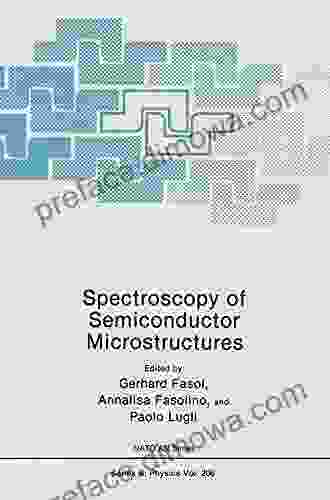Compound Semiconductor Photonics: Materials, Devices, and Integration - The Ultimate Guide

Compound semiconductor photonics is a rapidly growing field that has revolutionized the way we generate, transmit, and detect light. Compound semiconductors are materials that are made up of two or more elements, and they have properties that are different from those of the individual elements. This makes them ideal for use in photonic devices, which are used to manipulate light.
5 out of 5
| Language | : | English |
| File size | : | 8205 KB |
| Text-to-Speech | : | Enabled |
| Screen Reader | : | Supported |
| Enhanced typesetting | : | Enabled |
| Print length | : | 246 pages |
In this article, we will explore the basics of compound semiconductor photonics. We will discuss the different materials that are used in compound semiconductor photonics, the devices that are made from these materials, and the integration of these devices into photonic systems.
Materials for Compound Semiconductor Photonics
The most common materials used in compound semiconductor photonics are gallium arsenide (GaAs),indium phosphide (InP),and aluminum gallium arsenide (AlGaAs). These materials have a number of properties that make them ideal for use in photonic devices, including:
* High refractive index * Wide bandgap * Direct bandgap * High carrier mobility
These properties allow compound semiconductors to be used to create a wide variety of photonic devices, including lasers, LEDs, photodetectors, and solar cells.
Devices Made from Compound Semiconductors
Compound semiconductors are used to make a wide variety of photonic devices. Some of the most common devices include:
* Lasers: Lasers are devices that emit coherent light. Compound semiconductor lasers are used in a wide variety of applications, including telecommunications, imaging, and medical devices. * LEDs: LEDs are devices that emit light when they are biased with an electric current. Compound semiconductor LEDs are used in a wide variety of applications, including displays, lighting, and automotive taillights. * Photodetectors: Photodetectors are devices that convert light into an electrical signal. Compound semiconductor photodetectors are used in a wide variety of applications, including telecommunications, imaging, and medical devices. * Solar cells: Solar cells are devices that convert light into electricity. Compound semiconductor solar cells are used to power a wide variety of devices, including satellites, calculators, and portable electronics.
Integration of Compound Semiconductor Devices
The integration of compound semiconductor devices into photonic systems is a complex process. However, it is essential for the development of high-performance photonic systems. The integration of compound semiconductor devices can be achieved using a variety of techniques, including:
* Epitaxial growth: Epitaxial growth is a process in which thin layers of semiconductor material are grown on a substrate. Epitaxial growth can be used to create complex structures that are required for photonic devices. * Wafer bonding: Wafer bonding is a process in which two or more semiconductor wafers are bonded together. Wafer bonding can be used to create complex photonic devices that are not possible to create using epitaxial growth alone. * Hybrid integration: Hybrid integration is a process in which compound semiconductor devices are integrated with other types of devices, such as silicon-based devices. Hybrid integration can be used to create photonic systems that combine the best of both worlds, such as high-performance compound semiconductor devices and low-cost silicon-based devices.
The Future of Compound Semiconductor Photonics
The future of compound semiconductor photonics is very bright. Compound semiconductor photonics is a rapidly growing field that is expected to continue to grow in the years to come. This growth is being driven by the development of new materials, devices, and integration techniques.
Compound semiconductor photonics is expected to have a major impact on a wide variety of applications, including telecommunications, imaging, and medical devices. In the coming years, we can expect to see the development of new and innovative photonic devices that will revolutionize the way we interact with the world around us.
Compound semiconductor photonics is a rapidly growing field that has the potential to revolutionize the way we generate, transmit, and detect light. This article has provided a brief overview of the materials, devices, and integration of compound semiconductor photonics. For more information on this topic, please refer to the following references.
References
* [1] S. Adachi, "Properties of Group-IV, III-V and II-VI Semiconductors," John Wiley & Sons, 2005. * [2] M. A. Herman, "Fundamentals of III-V Semiconductors," Academic Press, 1996. * [3] R. E. Nahory and H. M. Kasper, "Compound Semiconductor Photonics," IEEE Journal of Selected Topics in Quantum Electronics, vol. 6, no. 6, pp. 1345-1370, 2000.
5 out of 5
| Language | : | English |
| File size | : | 8205 KB |
| Text-to-Speech | : | Enabled |
| Screen Reader | : | Supported |
| Enhanced typesetting | : | Enabled |
| Print length | : | 246 pages |
Do you want to contribute by writing guest posts on this blog?
Please contact us and send us a resume of previous articles that you have written.
 Book
Book Novel
Novel Page
Page Chapter
Chapter Text
Text Story
Story Genre
Genre Reader
Reader Library
Library Paperback
Paperback E-book
E-book Magazine
Magazine Newspaper
Newspaper Paragraph
Paragraph Sentence
Sentence Bookmark
Bookmark Shelf
Shelf Glossary
Glossary Bibliography
Bibliography Foreword
Foreword Preface
Preface Synopsis
Synopsis Annotation
Annotation Footnote
Footnote Manuscript
Manuscript Scroll
Scroll Codex
Codex Tome
Tome Bestseller
Bestseller Classics
Classics Library card
Library card Narrative
Narrative Biography
Biography Autobiography
Autobiography Memoir
Memoir Reference
Reference Encyclopedia
Encyclopedia Doann Houghton Alico
Doann Houghton Alico Travis Elborough
Travis Elborough Nikki Jefford
Nikki Jefford Bob Orrell
Bob Orrell Jennifer Diemer
Jennifer Diemer Diane Scarazzini
Diane Scarazzini Rohit Gupta
Rohit Gupta Kiini Ibura Salaam
Kiini Ibura Salaam Lisa Nirell
Lisa Nirell Dennis Winegarner
Dennis Winegarner Derek Shupert
Derek Shupert Don Kesterson
Don Kesterson Dolvie Ndifor
Dolvie Ndifor Tim Jepson
Tim Jepson Diane Chandler
Diane Chandler Donald Olson
Donald Olson Dino Esposito
Dino Esposito Diane Kredensor
Diane Kredensor Denis Rothman
Denis Rothman Sarah Gailey
Sarah Gailey
Light bulbAdvertise smarter! Our strategic ad space ensures maximum exposure. Reserve your spot today!
 Joseph HellerFollow ·10.9k
Joseph HellerFollow ·10.9k Jason HayesFollow ·14.6k
Jason HayesFollow ·14.6k James JoyceFollow ·5.8k
James JoyceFollow ·5.8k Gene SimmonsFollow ·18.2k
Gene SimmonsFollow ·18.2k Herbert CoxFollow ·11.8k
Herbert CoxFollow ·11.8k Colt SimmonsFollow ·9.1k
Colt SimmonsFollow ·9.1k Demetrius CarterFollow ·15.1k
Demetrius CarterFollow ·15.1k Michael CrichtonFollow ·2.2k
Michael CrichtonFollow ·2.2k

 John Steinbeck
John SteinbeckUnveiling the Return of the Antichrist and the New World...
As darkness descends upon the...

 Kenzaburō Ōe
Kenzaburō ŌeEmbark on an Unforgettable Journey: "Something Lost...
Prepare to be captivated as you...

 Hunter Mitchell
Hunter Mitchell"The Penguin Who Knew Too Much": A Captivating Mystery on...
Prepare yourself for an...

 Jack Powell
Jack PowellMaster the Art of Staying Present and Profitable in the...
In the relentless...

 Pete Blair
Pete BlairEscape into a Tropical Paradise with "Toucan Keep Secret"
Immerse Yourself in the Vibrant World of a...
5 out of 5
| Language | : | English |
| File size | : | 8205 KB |
| Text-to-Speech | : | Enabled |
| Screen Reader | : | Supported |
| Enhanced typesetting | : | Enabled |
| Print length | : | 246 pages |













